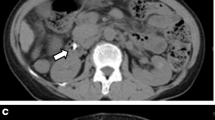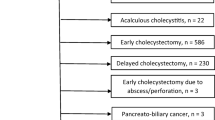Abstract
Cardiac transplant is performed with increasing frequency as the treatment for end-stage cardiac disease. Although cholelithiasis is more frequent in both pretransplant and posttransplant patients, no standard management approach exists. Because many such patients are cared for outside the transplant center, it is important that general surgeons develop an appropriate strategy to manage this entity. We present our experience with 11 patients from our institution who underwent cholecystectomy before or after cardiac transplantation. In addition, we have reviewed the 76 reported cases of cholecystectomy performed in precardiac or postcardiac transplant patients from centers throughout the world. Any procedure in this patient group requires critical consideration in regard to the timing and type of procedure. Pretransplant patients are well recognized cardiac risks, and posttransplant immuno-suppressed patients are at considerable risk for septic complications. Six patients underwent cholecystectomy prior to heart transplant. Five were performed laparoscopically, one as an open procedure. We also report five laparoscopic cholecystectomies in patients after cardiac transplant. One patient in the pretransplant group died 7 days after surgery from an uncontrollable arrhythmia. There were no hemodynamic or septic complications in either group. Current summated experience (87 cases) indicates that the mortality rate for urgent cholecystectomy in the posttransplant group is at least 36%. Because the first presentation of gallstones in this population is often acute cholecystitis, asymptomatic calculi cannot be considered benign. Elective cholecystectomy, laparoscopic or open, is tolerated well both before and after transplant. Given these facts, it seems reasonable to recommend pretransplant screening and posttransplant surveillance for gallstones. Prophylactic pretransplant laparoscopic cholecystectomy should be undertaken in the stable patient to avoid the substantial mortality associated with postoperative acute cholecystitis.
Résumé
La transplantation cardiaque est effectuée de plus en plus souvent pour des maladies cardiaques terminales. La lithiase biliaire se voit plus fréquemment avant et après transplantation chez ces patients, mais il n'existe pas de plan thérapeutique standardisé. Etant donné que beaucoup de ces patients sont soignés en dehors des centres de transplantation, il est important que les chirurgiens généraux aient une approche thérapeutique appropriée pour traiter ces patients. Les problèmes essentiels à étudier concernent le moment et le type d'intervention. Le patient pré-transplantation a, de toute évidence, des risques cardiaques élevés, alors que le patient en post transplantation est immunodéprimé, et les risques septiques sont élevés. Nous présentons notre expérience chez 11 patients ayant eu une cholécystectomie soit avant soit après une transplantation cardiaque. Nous avons également analysés les résultats de 76 patients ayant eu une cholécystectomie dans les autres centres de transplantation cardiaque dans le monde. Six patients ont eu une cholécystectomie avant leur transplantation cardiaque, cinq sous coelioscopie, une à ciel ouvert. Cinq patients ont eu une cholécystectomie sous coelioscopie en post-transplantation. Un patient pré-transplantation est décédé sept jour après l'intervention d'arhythmie incontrôlable. Il n'y a eu aucune complication hémodynamique ou septique dans les deux groupes. L'expérience cumuléc (87 cas) indique que la mortalité en cas ce cholécystectomie en urgence chez le patient post-transplantation est d'au moins 36%. Etant donnée que la première manifestation de la lithiase dans cette population est souvent la cholécystite aiguë, la lithiase asymptomatique ne peut être négligée et considérée sans gravité. La cholécystectomie élective, soit coelioscopique soit traditionnelle est bien tolérée chez le patient pré et post-transplantation. A la lumière de ces données, il semble raisonnable de recommander un programme de détection de lithiase pré et post-transplanation. La cholécystectomie pré-transplantation doit être conseillée chez un patient stable afin d'éviter une mortalité postopératoire élevée en cas de cholécystite aiguë.
Resumen
El transplante cardíaco se realiza con creciente frecuencia como la modalidad terapéutica para la enfermedad cardíaca terminal. Aunque la colelitiasis es más frecuente tanto en los pacientes pre como en los post-trasplante, no existe un manejo estandarizado. Puesto que muchos de los pacientes son tratados por fuera de los centros de trasplante, es importante que los cirujanos generales desarrollen una estrategia apropiada para el manejo de esta entidad. En el presente artículo presentamos nuestra experiencia con 11 pacientes de nuestra institución sometidos a colecistectomía antes o después del trasplante cardíaco. Además, hemos revisado los 76 casos informados de colecistectomía practicada en pacientes pre o post-trasplante en diferentes centros del mundo. Cualquier procedimiento en este grupo de pacientes requiere consideración minuciosa en relación a la oportunidad de realizar la operación, así como al tipo de procedimiento. Los pacientes pretrasplante son de reconocido riesgo cardíaco, en tanto que los pacientes post-trasplante están immunosuprimidos y exhiben riesgo considerable de complicaciones sépticas. Seis pacientes fueron sometidos a colecistectomía con anterioridad al trasplante cardíaco; 5 se hicieron por vía laparoscópica y 1 por laparatomía. También informamos sobre 5 colecistectomías laparoscópicas practicadas luego del trasplante cardíaco. Un paciente en el grupo pretrasplante murió a los 7 días después de la cirugía por arritmia incontrolable. No se presentaron complicaciones hemodinámicas o sépticas en estos dos grupos. La experiencia acumulada (87 casos) indica que la tasa de mortalidad para la colecistectomía de urgencia en el grupo post-transplante es por lo menos de 36%. Puesto que la primera presentación de los cálculos biliares en esta población de pacientes con frecuencia es colecistitis aguda, los cálculos asintomáticos no pueden ser considerados como benignos. La colecistectomía electiva, laparoscópica o abierta, es bien tolerada tanto por los pacientes pretrasplante como por los post-trasplante. Planteados estos hechos, parece razonable recomendar tamizaje pretrasplante y seguimiento post-trasplante en lo pertinente a la existencia de cálculos biliares. La colecistectomía laparoscópica profiláctica pretrasplante debe ser emprendida en el paciente estable a fin de disminuir la sustancial mortalidad postoperatoria de la colecistitis aguda.
Similar content being viewed by others
References
Bortnichak, E.A., Freeman, D.H., Jr., Ostfeld, A.M., et al.: The association between cholesterol cholelithiasis and coronary heart disease in Framingham, Massachusetts. Am. J. Epidemiol. 121:19, 1985
Bates, T., Harrison, M., Lowe, D., Lawson, C., Padley, N.: Longitudinal study of gall stone prevalence at necropsy. Gut 33:103, 1992
Lorber, M.I., Van Buren, C.T., Flechner, S.M., Williams, C., Kahan, B.D.: Hepatobiliary and pancreatic complications of cyclosporine therapy in 466 renal transplant recipients. Transplantation 43:35, 1987
Steck, T.B., Costanzo-Nordin, M.R., Keshavarzian, A.: Prevalence and management of cholelithiasis in heart transplant patients. J. Heart Lung Transplant. 10:1029, 1993
Spes, C.H., Angermann, C.E., Beyer, R.W., et al.: Increased incidence of cholelithiasis in heart transplant recipients receiving cyclosporine therapy. J. Heart Transplant. 9:404, 1990
Stone, B., Warty, V., Dinzans, V., Van Thiel, D.: The mechanism of cyclosporine induced cholestasis in the rat. Transplant. Proc. 20(Suppl. 3):841, 1988
Le Thai, B., Dumont, M., Michel, A., Erlinger, S., Houssin, D.: Cyclosporine induced cholestasis: inhibition of bile acid secretion is caused by the parental molecule. Transplant. Proc. 19:4149, 1987
Schade, R.R., Guglielmi, A., Van Thiel, D.H., et al.: Cholestasis in heart transplant recipients treated with cyclosporine. Transplant. Proc. 4(Suppl. 1):2757, 1983
Girardet, R.E., Rosenbloom, P., DeWeese, B.M., et al.: Significance of asymptomatic biliary tract disease in heart transplant recipients. J. Heart Transplant. 8:391, 1989
Boline, G.B., Gifford, R.R.M., Yang, H.C., et al.: Cholecystectomy in the potential heart transplant patient. J. Heart Lung Transplant. 10:269, 1991
Carroll, B.J., Chandra, M., Phillips, E.H., Harold, J.G.: Laparoscopic cholecystectomy in the heart transplant candidate with acute cholecystitis. J. Heart Lung Transplant. 11:831, 1992
Louie, H.W., Laks, H., Milgalter, E., et al.: Ischemic cardiomyopathy: criteria for coronary revascularization and cardiac transplantation. Circulation 84(Suppl. 5):290, 1991
Stevenson, L.W., Hamilton, M.A., Tillisch, I.H., et al.: Decreasing survival benefit from cardiac transplantation for outpatients as the waiting list lengthens. J. Am. Coll. Cardiol. 18:919, 1991
Georgen, R.F., Dietrick, J.A., Pifarre, R., Scanlon, P.J., Prinz, R.A.: Placement of intra-aortic baloon pump allows definitive biliary surgery in patients with severe cardiac disease. Surgery 106:808, 1989
Rademaker, B.M., Ringers, J., Odoom, J.A., de Wit, L.T., Kalkman, C.J., Oosting, J.: Pulmonary function and stress response after laparoscopic cholecystectomy: comparison with subcostal incision and influence of thoracic epidural anesthesia. Anesth. Analg. 75:31, 1992
Safran, D., Sgambati, S., Orlando, R., III: Laparoscopy in high-risk cardiac patients. Surg. Gynecol. Obstet. 176:548, 1993
Westerband, A., Van De Water, J.M., Amzallag, M., et al.: Cardiovascular changes during laparoscopic cholecystectomy. Surg. Gynecol. Obstet. 175:535, 1992
Wittgen, C.M., Andrus, C.H., Fitzgerald, S.D., Baudendistel, L.J., Dahms, T.E., Kaminski, D.L.: Analysis of the hemodynamic and ventilatory effects of laparoscopic cholecystectomy. Arch. Surg. 126: 997, 1991
Steed, D.L., Brown, B., Reilly, J.J., et al.: General surgical complications in heart and heart-lung transplantation. Surgery 98:739, 1985
Colon, R., Frazier, O.H., Kahan, B.D., et al.: Complications in cardiac transplant patients requiring general surgery. Surgery 103:32, 1988
Jones, M.T., Menkis, A.H., Kostuk, W.J., McKenzie, F.N.: Management of general surgical problems after cardiac transplantation. Can. J. Surg. 31:259, 1988
Parascandola, S.A., Wisman, C.B., Burg, J.E., Davis, P.K.: Extracardiac surgical complications in heart transplant recipients. J. Heart Transplant. 8:400, 1989
DiSesa, V.J., Kirkman, R.L., Tilney, N.L., Mudge, G.H., Collins, J.J., Cohn, L.H.: Management of general surgical complications following cardiac transplantation. Arch. Surg. 124:539, 1989
Villar, H.V., Neal, D.D., Levinson, M., et al.: Gastrointestinal complications after human heart transplantation and mechanical heart replacement. Am. J. Surg. 157:168, 1989
Aarnio, P., Harjula, A., Heikkila, L., Mattila, S.: Surgery after heart transplantation. Transplant. Proc. 22:190, 1990
Sekela, M.E., Hutchins, D.A., Young, J.B., Noon, G.P.: Biliary surgery after cardiac transplantation. Arch. Surg. 126:571, 1991
Augustine, S.M., Yeo, C.J., Buchman, T.G., Achuff, S.C., Baumgartner, W.A.: Gastrointestinal complications in heart and in heart-lung transplant patients. J. Heart Lung Transplant. 10:547, 1991
Lopez, P., Perrone, S.V., Kaplan, J., et al.: Laparoscopic cholecystectomy in heart transplant recipients. J. Heart Lung Transplant. 12:147, 1993
Venkataramanan, R., Perez, H.D., Schwinghammer, T., et al.: Effect of bile on cyclosporine absorption in dogs. Res. Commun. Chem. Pathol. Pharmacol. 1:137, 1986
Author information
Authors and Affiliations
Rights and permissions
About this article
Cite this article
Begos, D.G., Franco, K.L., Baldwin, J.C. et al. Optimal timing and indications for cholecystectomy in cardiac transplant patients. World J. Surg. 19, 661–667 (1995). https://doi.org/10.1007/BF00294752
Issue Date:
DOI: https://doi.org/10.1007/BF00294752




